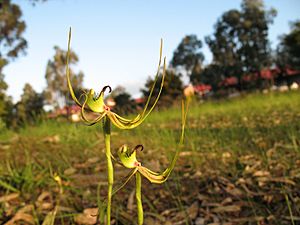Forest mantis orchid facts for kids
Quick facts for kids Forest mantis orchid |
|
|---|---|
 |
|
| C. attingens subsp. attingens growing in Donnybrook | |
| Scientific classification |
|
| Kingdom: | Plantae |
| Clade: | Tracheophytes |
| Clade: | Angiosperms |
| Clade: | Monocots |
| Order: | Asparagales |
| Family: | Orchidaceae |
| Subfamily: | Orchidoideae |
| Tribe: | Diurideae |
| Genus: | Caladenia |
| Species: | |
| Subspecies: |
C. a. subsp. attingens
|
| Trinomial name | |
| Caladenia attingens subsp. attingens |
|
| Synonyms | |
|
Arachnorchis attingens (Hopper & A.P.Br.) D.L.Jones & M.A.Clem subsp. attingens |
|
The forest mantis orchid or sneezing spider orchid is a special type of orchid. Its scientific name is Caladenia attingens subsp. attingens. This beautiful plant is only found in the south-west part of Western Australia. It's quite common to see it growing there.
This orchid usually has one tall, hairy leaf. It also grows one or two colorful flowers. These flowers are often green, yellow, and red. The forest mantis orchid looks a bit like another orchid, the fringed mantis orchid. But the forest mantis orchid has smaller flowers. It also grows further south in Western Australia.
What Does It Look Like?
The forest mantis orchid is a plant that grows from the ground. It has a special underground part called a tuber, which helps it store food. Each year, it grows a single, hairy leaf. This leaf can be about 6 to 20 centimeters (2.4 to 7.9 inches) long. It is also about 0.5 to 1 centimeter (0.2 to 0.4 inches) wide.
The orchid produces one or two striking flowers. These flowers are usually 6 to 8 centimeters (2.4 to 3.1 inches) long. They are also 5 to 7 centimeters (2.0 to 2.8 inches) wide. They grow on a stalk that can be 20 to 45 centimeters (7.9 to 17.7 inches) tall.
Flower Parts
The flower has parts called sepals and petals. These parts have thin, brown, club-like tips. These tips can be 0.5 to 2 centimeters (0.2 to 0.8 inches) long.
- The top sepal stands upright. It is about 3.5 to 6 centimeters (1.4 to 2.4 inches) long. It is also 0.3 to 0.6 centimeters (0.1 to 0.2 inches) wide.
- The side sepals are similar in size. They point upwards and are parallel to each other.
- The petals are 2.5 to 4 centimeters (1.0 to 1.6 inches) long. They are about 0.2 centimeters (0.1 inches) wide. They are arranged like the side sepals.
The most interesting part is the labellum. This is the orchid's "lip." It is 1.2 to 2 centimeters (0.5 to 0.8 inches) long. It is also 1.5 to 2.4 centimeters (0.6 to 0.9 inches) wide. The labellum is green with a dark red tip. Its sides have narrow teeth, up to 0.5 centimeters (0.2 inches) long. There are also many crowded, red bumps called calli. These calli are up to 0.4 centimeters (0.2 inches) long. They run along the center of the labellum, even near its tip.
This orchid usually flowers from late September to early November.
Naming the Orchid
Scientists officially described Caladenia attingens in 2001. This was done by two botanists, Stephen Hopper and Andrew Phillip Brown. They published their findings in a science journal called Nuytsia.
The name "attingens" comes from a Latin word. It means "reaching out." This name refers to the calli on the labellum. These calli "reach out" all the way to the tip of the labellum.
Where It Grows
The forest mantis spider orchid grows in woodlands, forests, and heathlands. You can find it between the towns of Bunbury and Albany. These areas are part of several natural regions in Western Australia. These include the Jarrah Forest, Mallee, Swan Coastal Plain, and Warren regions.
Is It Protected?
The Western Australian Government's Department of Parks and Wildlife has looked at this orchid. They have classified Caladenia attingens subsp. attingens as "not threatened." This means it is not currently at risk of disappearing.

